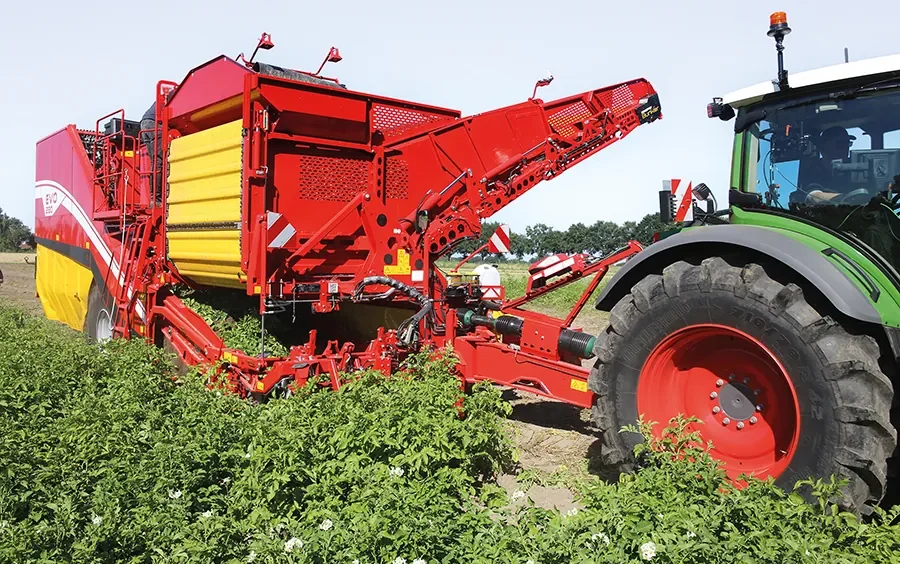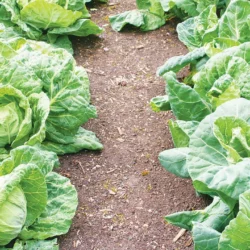The event, held on a farm in northern Germany, saw customer requests for new features satisfied by the specialist root crop machinery producer.
For those growing potatoes and onions, a new option for the Evo harvester makes it easy to alternate between harvesting the crops within just a few minutes, and a new harvester designed around an air separation system was also shown for the first time. There were also improvements to sugar beet harvesters and upgrades to the Matrix precision drill.
Continued investment
The event began with a presentation highlighting Grimme’s continued commitment to the agricultural industry, including investment totalling €40–50M in recent years across its plants. As far as UK customer demand for Grimme products is concerned, where last year sales were down mainly due to prolonged inclement weather, this year demand is higher, and the company predicts good results.
Directors, Christoph and Phillip Grimme told Farmers Guide during an exclusive interview that Grimme invests 10% of its annual turnover in R&D. “We are investing significantly to meet customer demand for added automation,” explained Phillip.
“Shortages of capable staff are an issue across the industry, and we need to find solutions. For example, current harvester-based sorting systems relying on teams of workers standing around a picking table will become outdated, and we believe that optical sorting technology is key to creating an automated alternative. Trials of systems are proving successful, but we won’t release anything that isn’t completely market-ready, because we know our customers can’t afford to have clods of soil and stones ending up in bags of vegetables sold in shops.
“There is still plenty of scope for innovations in terms of mechanical products too, and we continue to react to customer requests for new machines and improvements.”
Not just root crops
Although Grimme is particularly well known for its potato, onion and sugar beet machinery, Phillip pointed out that the company is also leading the way in terms of harvesting of other specialised crops including cabbages. “Our machines successfully harvest cabbages while handling them as gently as human pickers,” he explained.
Asked why customers in the UK and across Europe are so loyal to the Grimme brand, Phillipe said one major reason is the close connection between the company’s service department and product users.
“Customers have faith in our teams of qualified, experienced engineers to solve issues quickly when they arise. In terms of sales, everyone knows that our products work but it’s delivering exceptional back-up that means customers continue to buy.
“Users would sense immediately if our service deteriorated. We must always improve – supplying parts quickly isn’t an advantage if they are wrong, so all aspects of our business must contribute to the positive customer experience.”
Quick change intake head benefits potato and onion growers
Harvester innovations at the Grimme press event included a quick-change intake head for the Evo 280 harvester. “We expect strong demand as this increases flexibility for those harvesting a mix of crops – particularly potatoes and onions,” explained Grimme UK marketing manager, Adam Johnson.
The new MultiCrop intake system allows the lifter to be swapped in a matter of minutes, meaning only one machine is needed for harvesting multiple crops on the same day.
Apart from releasing the fixing pins and hydraulic hoses, the swapping process is completed from the tractor cab. At the Grimme event, heads were swapped in the field on uneven ground quickly and easily.
A standardised interface for electrics and the oil supply is used, and different intakes for different crops can be coupled with the swing frame, taking channel width into account. The attachment locking system is tool-free and accessed safely from one side of the machine. The Grimme Digital interface also adapts to a new head being attached at the touch of a button.
Specific crop intakes can be configured separately from the machine. All known intake versions are available including further options for harvesting various crops out of ridges, beds or in windrows.
At the Grimme event, the Evo 280 was demonstrated lifting potatoes and then 15 minutes later harvesting windrowed onions.
Easily swapped third separator
To enable effective multi-crop harvesting and use in different conditions, the Evo 280 can be fitted with alternative third separators in an optional exchangeable frame. Changeover from finger web (ClodSep) to deflection rollers (EasySep) and vice versa is completed by two people in approximately 30 minutes with the aid of a telescopic handler.
In addition to the separator, the operating software is also changed at the touch of a button, so the correct interface is always available.
For tractors with TIM compatibility, Speedtronic cruise is an option. Operating within pre-set parameters the travel speed automatically adjusts to achieve the optimum balance between throughput and crop protection, ensuring a constant work rate and reducing operator fatigue.
Improving comfort for the picking team, the right-hand side of the operator platform can be extended. Customers can choose between a short, wide or long, narrow trash conveyor to suit their situation.
The new Evo 280 with MultiCrop intake is available to order now, although numbers are limited for the 2025 season.
Stone separation without damage
A new harvester built around the established AirSep crop separation system was demonstrated. Adam Johnson explained that the Airsep 290’s main appeal will be for those growing potatoes for premium markets where the gentle sorting action avoids crop damage, especially in areas where achieving stone separation during spring ahead of planting can be a challenge due to soil or weather conditions. Cost savings are available to growers through avoiding the need for time-consuming separation of stones from soil pre-planting.
Two powerful fans requiring 50–60hp generate airflow through which the crop passes after leaving the roller table. The air flow is set according to typical weight and surface area of the crop. Anything lighter is lifted by the airflow and carried in the air and discharged through ducting at the rear of the machine. Heavier objects like stones drop down, while potatoes ‘float’ in the air.
Cross conveyors eject stones from the sides of the machine, but where growers want to drop them in a particular location then the conveyors can be stopped allowing up to 1m3 of stones to be accumulated before they are discharged in piles.
Grimme recommends tractors of 220–250hp to operate the harvester and power the fans, although the requirement varies according to the terrain and ground conditions.
Hydraulic drive for the produce handling and cleaning systems makes it easier to infinitely adjust the working speed of the webs to suit the conditions, independent of the tractor engine and PTO speed.
Additional new features include the ability to extend the left side of the picking platform to accommodate up to five people. Height adjustable steps are also available allowing people of different heights to work in comfort. The Airsep 290 is available with a standard conventional 9t bunker, or an optional 7.5t non-stop bunker. It enters production this year.
Extra automation and greater flexibility
The latest Toppa 600 six-row machine was displayed for the first time, complementing the Toppa 800 8-row model launched at Agritechnica last autumn.
The Toppa 600 combines two separate bodies each with a 180cm working width which top two outer beds at the rear, the gap between them topped by a central, front-mounted Toppa 200 flail topper.
Design highlights of the Toppa 200 include an extra length linkage, and depth control wheels between the front of the tractor and the topper. This provides extra space for a longer PTO shaft which avoids a steep PTO working angle – increasing efficiency and longevity.
The two rear flail units are mounted to the frame by central pivots allowing them to tilt laterally and accurately track the ground.
New options include hydraulic depth control, and a press roller to close the rows and keep the potatoes covered.
The two rear Toppa units can be adjusted manually, or automatically using crop feelers, with between +15 / -7cm side movement available to accommodate a range of crop row spacings.
The rear units can be lifted out of work independently, and with the Toppa 200 at the front and the Combi 600 at the rear, maximum width remains under 3m for transport.
Control is through Isobus using the tractor terminal or a Grimme CCI display.
Upgraded bed former
Revised BF and BFL bed formers for 1-, 2- or 3-bed systems were displayed, with a redesigned frame and a newly designed stone protection system. With the addition of a new BF 400m model, the line-up now comprises three models: all available from early 2025.
In addition to standard hydraulic stone protection, hydraulic Stone Protection Pro is a new option. A hydraulic cylinder allows each plough body to deflect even further upwards in the event of contact with obstructions. After being triggered, the working bodies automatically return to their working position.
A heavy-duty package is also available in conjunction with the new Pro system. This reinforces the side plates and plough bodies for extra stability in stony conditions.
New self-guiding plates have been developed for plough bodies of the BF series, designed for medium to heavy conditions. Attached to the body, they compress the walls to prevent soil falling and help form a stable bed.
New planter for separated/destoned and pre-tilled beds
The Prios 440 planter is now available with a chassis for bed cultivation. This allows potatoes to be planted in separated beds.
A new axle provides a tight steering angle of +/-30 degrees ensuring maximum manoeuvrability on the headlands, and a front-mounted guide wheel carries some of the weight and runs in the trough to help prevent crabbing when working offset.
The new hopper design provides capacity for 4t of seed.
Four furrow openers with individual control ensure constant planting depth even on undulating ground. One skid per bed monitors the depth, and coverage of the tubers is measured behind the planting elements by ultrasonic sensors. Fertiliser is delivered under the disc coulter into the side of the trough. New style openers feature a change of length and shape to give extra time for tubers to be accurately placed.
The fertiliser box, barrel system and planting elements can all be switched off separately from each other, and for each row via section control.
Other new innovations include a hard-wearing plastic shaping hood replacing the previous steel version to reduce ownership costs.
Updated sugar beet seeder
Ten years after the Matrix precision seeder’s debut, an updated version has been launched. Available in 12- and 18-row variants, the new seeder features a compact design, optimised weight distribution and improved adjustment systems. Adam Johnson told Farmers Guide that sales of the previous Matrix have all been for establishing sugar beet, and customers appreciate the accuracy, and section control that reduces seed wastage.
The new Matrix features new coulters, new leading wheels and a new pressure system. The seeder is capable of control direct from terminals of Isobus-equipped tractors, although using Grimme’s CCI display is recommended due to the amount of information displayed.
Rexor beet harvester upgrades
The latest, fourth generation Rexor beet harvester was previewed at Agritechnica, but Farmers Guide took the opportunity to see it working for the first time. Major updates include a completely new Claas cab – like that used on the latest Claas combines. New optional left-hand armrest-mounted controls add convenience. There are two joysticks as well as freely assignable controls combined with a 7.8in display. The left-hand controls are mainly used during the unloading process while harvesting or for unloading at the clamp.
The Speedtronic-Cruise assistance provides active control of the machine’s travel speed. Based on the selected driving mode, it regulates speed according to the crop load through different parts of the harvester.
Combined with standard Speedtronic for the conveying and cleaning unit, this provides almost completely autonomous operation once the machine is harvesting in the rows.
The new MTU 15.6-litre, 653hp engine is in a redesigned compartment allowing a 0.5m shorter machine length for improved compatibility with road transport regulations.
The hopper incorporates hatches at the rear to access the engine for servicing.
Grimme division manager for beet equipment, Jan Alexander Holtschulte said that improvements in sugar beet prices have increased market confidence, and interest in the new harvester as well as the new options has been considerable.




